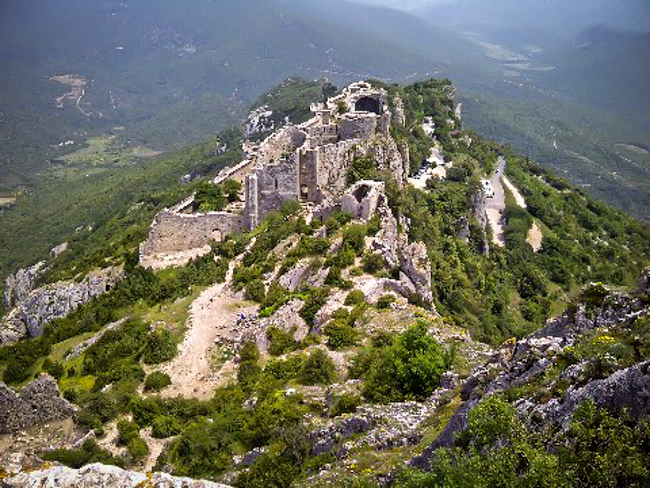Meddling With Medieval Mysteries: Hiking through history in Southern France
Climbing up the wide circular stone staircase to our hotel room in the Chateau des Ducs de Joyeuse on the first night, I knew this would be a very different trip. I could just as easily be entering a medieval castle as a lodging facility -- and then I found out I was, though I suspect our modernized room was a lot less drafty than those of the lords and ladies who preceded us.
The experience, near Les Oliviers south of Toulouse, certainly set the tone for our Southern France Walking Through History tour—conducted, ironically, by a company called New England Hiking. As we hiked through, around, up and over one medieval village after another, traversing castles and countryside and learning about the Middle Ages of the 11th-14th centuries, we were immersed in history.
According to our guide, Richard Posner, every mountain, every hill, has great historic and cultural significance, and his running commentary throughout the trip bore him out. Visigoth chateaux, Knights Templar towers, Cathar castles -- I knew little about these guys but by the time we finished visiting their many abodes, I felt we were all old friends.
The walks ranged from easy to moderately challenging and the talks from fascinating to eyes glazed over, usually in direct proportion to the difficulty of the hikes. As one of our compatriots enthused about Richard: “He opens his mouth and facts fall out.” The fact that he could make these facts endlessly interesting was the real accomplishment.
Our first visit was to a tiny medieval town, Cassaignes, that does not see a lot of drive-by traffic. Consisting of a few houses and churches dating back 900 years, the sense of history was somewhat moderated by the large red tractor beside one house that appeared anachronistic by many centuries.
Traveling from one medieval village to another, we heard stories of church intrigue and medieval love, military battles and religious controversies, mysterious anecdotes about priests and royals and other local residents that brought the towns to life in a very tangible way. For one, in the 1890’s a priest named Berenger Sauniere sold secret medieval documents he found in the hollows of the church at Rennes Les Chateaux for great sums of money. Those documents? Well, does Holy Grail mean anything to you?
Every morning Richard’s wife, Marion, scoured the market in preparation for our picnic lunch, composed of different breads, cheeses, fresh fruit, French sweets and some village delicacy such as pate or tapenade which we feasted upon overlooking a lake, a garden, a vineyard or some random medieval ruin.
Accompanying us on much of our journey were the Cathars, Roman Catholic heretics who were in prominence from the 10th-12th centuries and ultimately destroyed by the Crusades, and the Knights Templar, a well-financed military religious order of the 12th-14th centuries, and later rumored to be a secret society that exists to this day.
The impregnable Queribus Tower, the last Cathar castle to fall, was originally a 4th century Roman structure. It was later refurbished by the Cathars to resist attack during the Crusades. The most “recent” restorations? They took place in the 13th century. This sort of time warp is commonplace in southern France. The present and past coexist harmoniously as one can travel back and forth through multiple centuries within a few hours of day-to-day errands.
As we climbed the almost half-mile straight up, I couldn’t help but wonder, “Why would anyone want to attack this place?” Obviously, I wouldn’t have made a good candidate for medieval knighthood. Views from one tower to the next compete with each other for their own particular sense of wonder and enormity of vision. How often are you looking over a vast countryside from a 360 degree angle from multiple towers in a single day?
One morning early, Richard pointed knowingly to a small abbey halfway up a mountain. Our collective response was, “You’re kidding, of course?” He wasn’t. Not only did we make it to the St. Foy abbey, we reached the top of the mountain. Admittedly, the ascent itself was much less challenging than it appeared, but we still felt unduly proud.
Near Rennes les Bains, we stopped at Mount Cardou, where one of the most controversial Knights Templar theories is at hand—that within the mountainside is a cave containing the remains of the body of Christ. True or not, just standing there felt like a spiritual experience. The Knights were ostensibly eliminated as a religious order by the 14th century -- although that may be a surprise to modern authors who have perpetuated theories of their continued existence.
But nothing we had seen up to then could prepare us for Carcassone, one of Europe’s largest and best preserved fortified cities, an entire medieval town protected by almost two miles of double walls and 52 watchtowers.
Hard to imagine yourself walking among the knights, priests and ladies of the time with the proliferation of cafes and souvenir shops keeping you grounded in the modern world. Still, how often do you ask directions to a bathroom and are told to take a right turn over the drawbridge?
Late evening or early morning, when most of the tourists are gone, it’s much easier to imagine yourself a Cathar merchant meandering the cobblestone streets, through the maze of bridges, towers, concentric walls, castles, archways, tunnels and streets so narrow you can reach out your arms and touch both sides simultaneously. And once the crowds return, it’s possible to imagine another similarity to medieval times--only now the throngs, equally motivated, are coming to shop rather than siege.
As we left Carcassone, our exposure to medieval architecture and lifestyle wasn’t over, but our connection with the Cathars and Knights Templar was, so it seemed an appropriate time to say au revoir.
Fyllis Hockman is an award-winning travel journalist who has been traveling and writing for more than 25 years. She is still as eager for the next trip as she was for the first. Her articles appear in newspapers and online and can be found at seniorsoftheworld.com (The Travel Adventures of Fyllis and Vic) and elsewhere on YourLifeIsATrip.com.
[photography by Fyllis Hockman]





